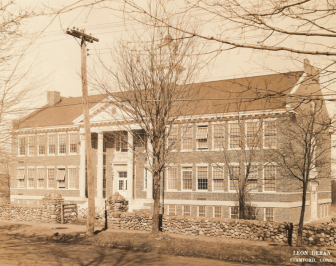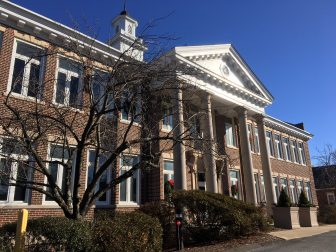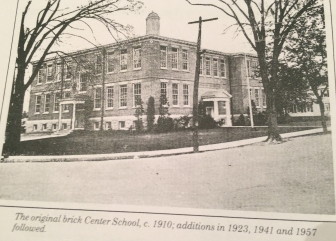[Editor’s Note: The following is published in advance of the “Forum on Public Buildings Part II,” to be held 6:30 to 9 p.m. on Wednesday, Jan. 9 at Town Hall. Questions for panelists can be submitted here.]
-

New Canaan High School was founded in 1927. Today it is the police department.
Built: 1926, opened 1927
- Square footage: 27,000
- Current uses: Headquarters of the New Canaan Police Department, New Canaan Parking Bureau
- Committee recommendations: Fund the architectural and engineering needed for renovations. Use ground and first floors for NCPD and upper floor for municipal offices and swing space.
- Relevant articles: First Selectman: Town, Covia $1.5 Million Apart on Price of Building (November 2018), ‘We Have To Figure Out an Answer’: Need To Expand Covia Building Complicates First Selectman’s Proposal for Combined Board of Ed-NCPD Home (November 2018), First Selectman: Police Building Ultimately Could Be Sold, Converted Into Senior Housing (July 2018), First Selectman: New Canaan ‘Very Interested’ in Acquiring Downtown Building for Combined Police, Board of Ed Headquarters (July 2018)
Submitted by Mimi Findlay:
Description
The current Police Station (the original New Canaan High School) is a 2-story structure of red brick and cut stone In the Georgian/Colonial Revival Style, designed in1926 by John Nobel Pierson and Son, Architects, Perth Amboy, NJ. The same architectural firm was again selected in 1932 for its neighbor, the former Junior High School, now the Schoolhouse Apartments.

New Canaan Police Department. Credit: Michael Dinan
John Noble Pierson & Son advertised themselves as “School House Specialists, having designed over eighty schools in ten years.” They designed in a variety of styles, including an Art Deco example in 1931 in Jamesburg, New Jersey, now converted to an office complex. It would appear that New Canaan requested something in the Colonial Revival Style to emphasize its colonial roots and as an appropriate style for a large, institutional structure. It was the fifth major Colonial Revival building in the downtown, following the 1910 Town Hall, 1913 Savings Bank and the Library of the same year, and the 1923 Playhouse.
All the original 12 over 12 sash of this red brick Colonial Revival building was replaced by casement sash in the 1980’s when it was converted to house the Police Department by Laurent Dupont architect. “…the windows retain their original jack arches and false keystones. A modillioned cornice runs all the way around the gables. At the gable ends are parapets. The central motif of the building is a large projecting, modillioned pediment which enframes a small oculus with four small keystones. The pediment is supported by four double-height Ionic columns. Beneath the projecting pediment there is a large entry with eared antepagments (trim added to door frame). Scrolled brackets support a heavy horizontal cornice, in the frieze of which is a lamp and garland decoration. Above that is a cartouche flanked by volute scrolls which read New Canaan Police. The ends of the building are articulated by brick quoining, and at the back of the pediments are brick pilasters with egg and dart ovolo molded pilaster capitals. The whole arrangement is topped by a Colonial Revival cupola that has quoining, a slightly projecting eave with brackets, topped by an open parapet, topped by a hexagonal cupola with louvered arches.”
It should be noted that, after a decade of disuse, in 1980-81 during its conversion into a Police Station, not only were the windows replaced but the ground in front of the entrance was raised to eliminate the 12-step flight of stairs supporting the four-columned portico. Laurent T. Dupont, was the architect
History
Center School, then known as the first school district, was formed in 1795 and the school site was on Seminary St. In 1851, Henry Barnard rewrote the State school laws and laid the foundations for a new State system of schools.

The rebuilt Center School, ca. 1910. Courtesy of the New Canaan Historical Society.
Center School had to be moved to a new structure to accommodate the new required curriculum and increasing number of students. The town laid out the first block of South Avenue, from Elm to Cherry Street and, with the completion of the new Center School, “the town in 1857 extended the unpaved South Avenue (called Broad Street then) through the school grounds and all the way to the Darien town line – a phenomenon of road planning in this part of the state, for South Avenue was and still is the longest and straightest stretch of road in town”. Almost 40 years later the town applied to the new state road maintenance fund for $3,000, which was spent on improving South Avenue “from Maple Street south as far as the appropriation will go.”
After c1900 New Canaan students had attended high school in Stamford, and by 1924 some 110 New Canaan students were enrolled there, 884 children were enrolled in the town’s public schools with 176 attending the three remaining district schools: Church Hill school on West Road, the Talmadge Hill school on lower Weed Street, and the Little Red Schoolhouse on Carter Street.
In 1925 Stamford voted to restrict non-resident students to the current school year. It was a rapidly changing time for New Canaan. The 1920’s saw the Town’s population jump by 40%, and important pieces of the downtown took shape in that period. In 1925 a series of town meetings were led to select a location for the new high school, with Mead Park finally winning the election, which was rescinded two weeks later. The a month later, on November 18 another town meeting accepted the gift of Edith (Olcott) and Barend Van Gerbig of four and a half acres on the east side of South Avenue, between Church and Oak Streets. The donors had been summer residents on Smith Ridge Road since 1912 and died there in the 1950’s. She was known for her generous gifts to the Association against the Prohibition Amendment because she thought prohibition was a farce, as well as gifts to almost all the local sports teams and other causes.
The architects were engaged, construction began and by July 5, 1926, although the building was only partially completed, the town celebrated the national Sesquicentennial on July 5 (because the 4th was a Sunday) with a parade, floats and dedication of its first high school. The cornerstone was laid by Francis E. Green, chairman of the Board of Education, aided by Henry Kelley, a member of the board who would serve until he died in 1949. The High School opened to admit students in 1927. Overcrowding was soon a problem so the Junior HIgh school was built on the north side of the Van Gerbig tract in 1931. The schools now offered manual training and other practical courses on a par with college-preparatory ones as the Depression was pointing up the need for vocational skills.
The fine public spirit shown by Mr. and Mrs. Van Gerbig in 1926 continues today with the many voluntary donations to improve the schools, and particularly their athletic facilities.
Information Compiled by Mimi Findlay, Co-Founder and President Emeritus of The New Canaan Preservation Alliance Inc. with years of preservation advocacy.